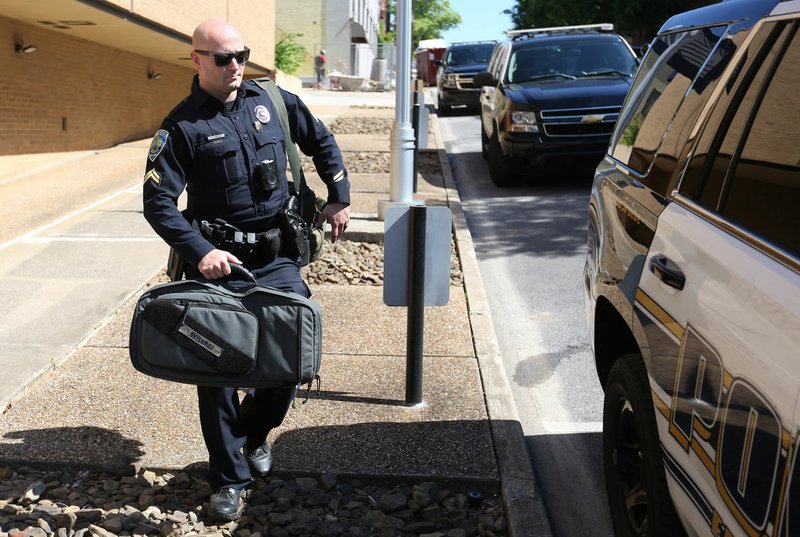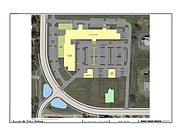FAYETTEVILLE -- Plans for a new police headquarters need to go back to the drawing board, police and architects heard from the City Council.
The council Tuesday reviewed conceptual plans for the public safety campus to be built at Porter Road and Deane Street. The site will include the main police station, indoor firing range, garages and storage buildings. The project stems from a $37 million bond issue voters approved a year ago to replace the undersized police station on Rock Street downtown.
Web watch
For more information on the Fayetteville police headquarters project, go to:
bit.ly/faypolicehq
To see conceptual drawings, go to the online version of this story:
The intersection at Porter Road and Deane Street also will get an overhaul. The corner will have a wider turning radius with a traffic light. Porter Road will go directly into the campus, with police and employee parking to the east and public parking to the west.
The city bought the 12 acre that was part of the University of Arkansas System Division of Agriculture farm for $2.59 million.
Police Chief Mike Reynolds said security for officers, employees and residents was at the forefront of the design.
"Times have changed," he said. "You have these lone-wolf attacks, and I think Dec. 7 proved we're not immune to that."
London Phillips shot and killed Officer Stephen Carr on Dec. 7 while Carr sat in his patrol vehicle in the police station's parking lot near the downtown square. The parking lot had no fence or barriers to separate officers from passersby.
Council members voiced displeasure with the layout of the site.
Reynolds said he's open to ideas. He has invited the council members to take part in a workshop to go over the design in detail. The goal always has been to balance good design with security and function, he said.
Criticism, praise
Hal Sargent, architect with Brinkley Sargent Wiginton, told the council the idea was to have separate areas for the public and for officers and employees. The firm has designed about 70 public safety buildings across the country, including a 100,000-square-foot public safety training center in Round Rock, Texas; an 85,000-square-foot municipal court and council chamber complex in Artesia, N.M.; and the University of Oklahoma's Police Department in Norman, Okla. The council hired the firm for $2.9 million last year.
The site layout has the main station and the firing range forming an L on the north and west sides of the campus. The lobby in the northwest corner connects the two pieces.
Parking for employee and police vehicles is in the center of the campus. Two small structures for storage sit on the southern edge of the employee parking lot. A public parking lot with 75 spaces separates Porter Road from the firing range building on the west side.
Council members paid particular attention to the public parking lot edging the street. The city's standard is to promote walkable communities, meaning buildings should address the public right of way, not parking lots.
Sargent said it's common practice for state and municipal public safety buildings to have 50 feet of separation between vehicles in a public parking lot and any part of a building. Putting the lot on the western edge allows for that amount of spacing, he said.
Having buildings close to the street can be problematic for a police station, Sargent said.
"We have an awful lot of access points, we have an awful lot of parking, and we need a secure perimeter," he said.
There also is a patch of open space south of the campus for a future police building. A fire station, one of two new ones in development in the city, would sit on the southern edge of the site near Deane Street.
Council Member Kyle Smith said he understood the need for security, but having a parking lot in front the building is bad design. The site plan also has a berm, which is a mound of soil with tall grass, and trees between a proposed trail along Porter Road and Deane Street. Smith said separating pedestrians farther from the buildings with a berm seemed absurd.
"I'm concerned that if we say for a civic building that doing good design is too hard, we lose all of our credibility for asking private developers to give us good design," he said.
The council praised the conceptual drawings of the buildings. The main entrance at the northwest corner is lined with windows reaching at an angle from the floor to the ceiling. A walkway and memorial monument for fallen officers would go out front. The drawings showed sandstone for the exterior of the buildings, which may change based on overall cost, Sargent said.
Council Member Matthew Petty said the buildings appeared to fit with the city's preferences for design. But the site layout appeared as though walkability standards were an afterthought, he said.
Petty said he could see several ways the site plan could change.
"I want you to imagine for one moment if that plaza was at the intersection, and how different this neighborhood could function for the residents who already live there," he said. "What a beautiful plaza to have at the intersection. It would be incredible."
Making adjustments
The idea of designing a police station or any municipal building that blends well with a neighborhood and also maintains security is one cities have addressed many times, said Robert Steuteville with Congress for the New Urbanism. The nonprofit organization in Washington works to diversify design in neighborhoods, address climate change and promote walkability, according to its website.
Security for a police campus lies more within its campus than out, Steuteville said. Public safety agencies may practice certain design standards in the name of security, but they aren't universal, and may have the unintended consequence of suburbanizing an otherwise desirable part of town, he said.
Having an inviting building layout also helps with perception, Steuteville said. It can make the difference between the feeling of police being in a neighborhood versus being a part of it, he said.
"Old buildings in cities are never 50 feet from the sidewalk," Steuteville said. "There is a price you pay in terms of moving the civic buildings away from the sidewalk and putting them on these suburban sites."
Cities can have the best of both worlds when it comes to police facilities, said Buck Mims, chief executive officer of the National Public Safety Group, a firm that consults departments on software, equipment and buildings. No one wants a police station to look like a military base, but security outweighs beauty, he said.
"I think there's a balance you can have where you're not so far off the road, but somebody can't just ride by and throw something against the building, or somebody can't just easily target the building without having to make an effort to come on the property to do that," Mims said.
Security inside and out are equally important, he said. Police stations need more security than a library or museum and being away from the street can help, he said.
"Every city has a look and a feel," Mims said. "You want the police department to embody the look and feel of your city. That's important, as long as it doesn't affect safety."
The city also has to consider the budget and timing associated with a bond issue project. The city will have to spend at least 80% of the bond money and have the remaining balance contractually committed by the end of 2022 to comply with U.S. Securities and Exchange Commission regulations.
Reynolds said he's confident the project will remain within the budget and stay on schedule. The point of presenting to the council was to get its feedback, and there's time to make changes to the site layout, he said.
A lot of adjustments can be made with an 80,000-square-foot campus, he said.
"Tuesday night was a bump in the road, but I don't think it's an inconceivable obstacle that we can't get together and work through," he said. "I think that's the point we're at right now."
NW News on 06/01/2020



